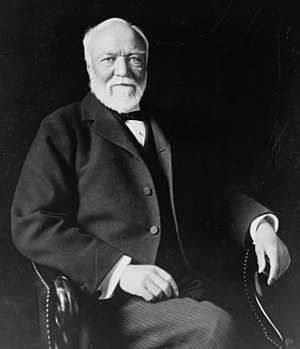Robot Hall of Fame
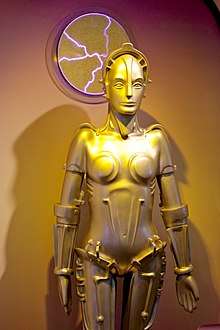
The Robot Hall of Fame is an American hall of fame that recognizes notable robots in various scientific fields and general society, as well as achievements in robotics technology. The organization was established in 2003 by the School of Computer Science at Carnegie Mellon University in Pittsburgh, Pennsylvania, as an acknowledgement of Pittsburgh's achievements in the field of robotics and with the aim of creating a broader awareness of the contributions of robotics in society.[1] The idea for the Robot Hall of Fame was conceived by Carnegie Mellon School of Computer Science dean James H. Morris, who described it as a means of "honor[ing] robots that have served an actual or potentially useful function and demonstrated real skill, along with robots that entertain and those that have achieved worldwide fame in the context of fiction."[1] The first induction ceremony was held at the Carnegie Science Center on November 10, 2003.[2] Thirty robots – both real and fictional – have been inducted into the Robot Hall of Fame since its inception.[3] An exhibit named Roboworld was later established at the Carnegie Science Center in June 2009, featuring a physical embodiment of the hall of fame.[4]
From 2003 to 2010, inductees to the Robot Hall of Fame were chosen by a selected panel of jurists.[5] The opportunity to nominate a robot for induction into the hall of fame was also made open to the public; nominators were required to submit a one-paragraph rationale explaining their selection.[1] The voting process was altered significantly in 2012, with nominations instead being gathered from a survey of 107 authorities on robotics and divided into four categories: Education & Consumer, Entertainment, Industrial & Service, and Research.[5] Through an online voting system, members of the public were allowed to vote for one nominee per category; only the top three nominees in each category, based on the results of the aforementioned robotics experts survey, are included on the ballot.[6][7] Officials subsequently derived the final list of inductees from both the survey and the public vote.[5] Robot Hall of Fame director Shirley Saldamarco said of the changes:
The technology and art of robotics are advancing at an increasingly rapid rate and so the Robot Hall of Fame also must evolve. As more students, workers and consumers become accustomed to robots, it seems like a natural step to give the public a voice in selecting inductees.[8]
No robots have been inducted into the Robot Hall of Fame since 2012.
Inductees
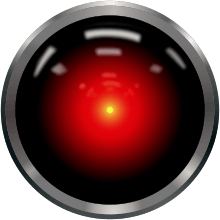
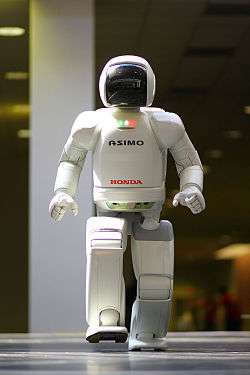
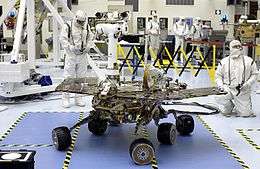
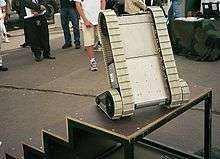
| Year | Name | Description | Creator | Category | Ref. |
|---|---|---|---|---|---|
| 2003 | HAL 9000 | Character from the film 2001: A Space Odyssey | Arthur C. Clarke | Entertainment | [9] |
| 2003 | R2-D2 | Character from the Star Wars franchise | George Lucas | Entertainment | [10] |
| 2003 | Sojourner | Mars exploration rover | NASA | Research | [11] |
| 2003 | Unimate | First industrial robot | George Devol, Joseph Engelberger | Industrial & Service | [12] |
| 2004 | ASIMO | Multi-functional humanoid robot | Honda | Research | [13] |
| 2004 | Astro Boy | Character from the Astro Boy franchise | Osamu Tezuka | Entertainment | [14] |
| 2004 | C-3PO | Character from the Star Wars franchise | George Lucas | Entertainment | [15] |
| 2004 | Robby the Robot | Character from the film Forbidden Planet | Cyril Hume | Entertainment | [16] |
| 2004 | Shakey | First general-purpose mobile robot to be able to reason its own actions | SRI International | Research | [17] |
| 2006 | AIBO | Robotic pet | Sony | Education & Consumer | [18] |
| 2006 | David | Character from the film A.I. Artificial Intelligence | Brian Aldiss | Entertainment | [19] |
| 2006 | Gort | Character from the film The Day the Earth Stood Still | Edmund H. North | Entertainment | [20] |
| 2006 | Maria | Character from the film Metropolis; cited as the first robot to be depicted in cinema | Thea von Harbou, Fritz Lang | Entertainment | [21] |
| 2006 | SCARA | Four-axis industrial robot arm | University of Yamanashi | Industrial & Service | [22] |
| 2008 | Lt. Cmdr. Data | Character from the Star Trek franchise | Gene Roddenberry | Entertainment | [23] |
| 2008 | Lego Mindstorms | Robot toy kit series | Lego | Education & Consumer | [24] |
| 2008 | Navlab 5 | Autonomous robotic vehicle | Carnegie Mellon School of Computer Science | Research | [25] |
| 2008 | Raibert Hopper | First self-balancing hopping robot | Marc Raibert | Research | [26] |
| 2010 | da Vinci Surgical System | Robotic surgical system | Intuitive Surgical | Industrial & Service | [27] |
| 2010 | Dewey | Characters from the film Silent Running | Steven Bochco, Michael Cimino, Deric Washburn | Entertainment | [27] |
| 2010 | Huey | ||||
| 2010 | Louie | ||||
| 2010 | Opportunity | Mars exploration rover | NASA | Research | [27] |
| 2010 | Roomba | Autonomous robotic vacuum cleaner | iRobot | Education & Consumer | [27] |
| 2010 | Spirit | Mars exploration rover | NASA | Research | [27] |
| 2010 | Terminator T-800 | Character from the Terminator franchise | James Cameron, Gale Anne Hurd | Entertainment | [27] |
| 2012 | BigDog | Quadrupedal military robot | Boston Dynamics, Foster-Miller, NASA Jet Propulsion Laboratory, Harvard University Concord Field Station | Research | [28] |
| 2012 | Nao | Autonomous humanoid robot | Aldebaran Robotics | Education & Consumer | [28] |
| 2012 | PackBot | Military robot | iRobot | Industrial & Service | [28] |
| 2012 | WALL-E | Character from the film WALL-E | Andrew Stanton | Entertainment | [28] |
See also
References
- 1 2 3 "Carnegie Mellon Announces Creation of The Robot Hall of Fame; Assembles a Panel of Renowned Judges to Select the First Inductees". Carnegie Mellon University. April 30, 2003. Archived from the original on July 29, 2013. Retrieved July 30, 2013.
- ↑ "Carnegie Mellon Inducts Four Robots into Newly Established Robot Hall of Fame". Carnegie Mellon University. November 10, 2003. Archived from the original on August 2, 2013. Retrieved July 30, 2013.
- ↑ "The Inductees". Robot Hall of Fame. Carnegie Mellon University. Archived from the original on August 14, 2013. Retrieved July 28, 2013.
- ↑ "Robots take center stage at Pittsburgh museum". Daily American. Tribune Company. June 6, 2009. Archived from the original on January 6, 2014. Retrieved July 30, 2013.
- 1 2 3 Ceceri, Kathy (September 4, 2012). "Vote for your favorite nominees to the Robot Hall of Fame". Wired. Condé Nast Publications. Retrieved July 30, 2013.
- ↑ Poeter, Damon (August 21, 2012). "Public Can Vote on Robot Hall of Fame 2012 Class". PC Magazine. Ziff Davis. Archived from the original on November 26, 2012. Retrieved July 30, 2013.
- ↑ "How are Robots Selected for the Robot Hall of Fame®?". Robot Hall of Fame. Carnegie Mellon University. Archived from the original on August 25, 2013. Retrieved July 28, 2013.
- ↑ Mosbergen, Dominique (August 20, 2012). "Robot Hall of Fame 2012: Vote for the Best And Most Innovative Robots in the World". The Huffington Post. AOL. Archived from the original on September 18, 2013. Retrieved July 30, 2013.
- ↑ "HAL 9000". Robot Hall of Fame. Carnegie Mellon University. Archived from the original on September 17, 2013. Retrieved July 28, 2013.
- ↑ "R2-D2". Robot Hall of Fame. Carnegie Mellon University. Archived from the original on May 16, 2013. Retrieved July 28, 2013.
- ↑ "Mars Pathfinder Sojourner Rover". Robot Hall of Fame. Carnegie Mellon University. Archived from the original on May 16, 2013. Retrieved July 28, 2013.
- ↑ "Unimate". Robot Hall of Fame. Carnegie Mellon University. Archived from the original on October 6, 2013. Retrieved July 28, 2013.
- ↑ "ASIMO". Robot Hall of Fame. Carnegie Mellon University. Archived from the original on May 12, 2013. Retrieved July 28, 2013.
- ↑ "Astro Boy". Robot Hall of Fame. Carnegie Mellon University. Archived from the original on May 17, 2013. Retrieved July 28, 2013.
- ↑ "C-3PO". Robot Hall of Fame. Carnegie Mellon University. Archived from the original on May 14, 2013. Retrieved July 28, 2013.
- ↑ "Robby, the Robot". Robot Hall of Fame. Carnegie Mellon University. Archived from the original on May 16, 2013. Retrieved July 28, 2013.
- ↑ "Shakey". Robot Hall of Fame. Carnegie Mellon University. Archived from the original on May 17, 2013. Retrieved July 28, 2013.
- ↑ "AIBO". Robot Hall of Fame. Carnegie Mellon University. Archived from the original on May 16, 2013. Retrieved July 28, 2013.
- ↑ "David". Robot Hall of Fame. Carnegie Mellon University. Archived from the original on May 12, 2013. Retrieved July 28, 2013.
- ↑ "Gort". Robot Hall of Fame. Carnegie Mellon University. Archived from the original on May 12, 2013. Retrieved July 28, 2013.
- ↑ "Maria". Robot Hall of Fame. Carnegie Mellon University. Archived from the original on May 14, 2013. Retrieved July 28, 2013.
- ↑ "SCARA". Robot Hall of Fame. Carnegie Mellon University. Archived from the original on May 14, 2013. Retrieved July 28, 2013.
- ↑ "Lt. Cmdr. Data". Robot Hall of Fame. Carnegie Mellon University. Archived from the original on August 14, 2013. Retrieved July 28, 2013.
- ↑ "Lego® Mindstorms®". Robot Hall of Fame. Carnegie Mellon University. Archived from the original on August 14, 2013. Retrieved July 28, 2013.
- ↑ "NavLab 5". Robot Hall of Fame. Carnegie Mellon University. Archived from the original on August 14, 2013. Retrieved July 28, 2013.
- ↑ "Raibert Hopper". Robot Hall of Fame. Carnegie Mellon University. Archived from the original on August 25, 2013. Retrieved July 28, 2013.
- 1 2 3 4 5 6 "Robot Hall of Fame Announces New Inductees". The Robotics Institute. Carnegie Mellon University. April 21, 2009. Archived from the original on September 25, 2016. Retrieved July 28, 2013.
- 1 2 3 4 Heater, Brian (October 23, 2012). "Robot Hall of Fame inducts Big Dog, PackBot, Nao and WALL-E (video)". Engadget. AOL. Archived from the original on July 25, 2013. Retrieved July 28, 2013.

.svg.png)
